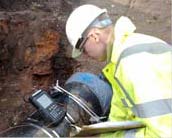Flow Meter Calibration
Where it is not possible to remove the meter from the field, it is possible to undertake liquid flow meter calibrationor verify the device in-situ. Many meters can be verified utilising specialist simulators. This can establish and eliminate errors between the meter, it's transmitter and signal loops. Calibrated reference meters can be utilised to establish the accuracy of the primary element to within +/-2%*. RS Hydro provide a total solution service to end users of all meters: removal, recalibration and re-installation. We offer a service that is unparalleled in the UK, for cost, quality and efficiency.
For users of industrial flowmeters who need to keep their instruments running at optimum performance levels, RS Hydro has the capability to offer a comprehensive calibration and repair service. Utilising EON's UKAS accredited 28-tonne gyroscopic weigh tank and bridge, RS Hydro can calibrate flow meters to an accuracy of +/-0.1%. The 18m calibration rig is available to test and certify electromagnetic, vortex, variable area, swirl and DP (differential pressure) instruments ranging from 50 to 600m, flow rates from 2.5 to 440l/sec and differential pressures from 50 to 2500mbar. The water can also be heated to 40 deg C if required to increase the Reynolds Number.
Why is Flowmeter Accuracy Important ?
To be sure that your flowmeter has been calibrated as accurately as possible, you should be sure to ask calibration and repair establishments the following questions:
Does the flow meter calibration figure include flow rig uncertainty ?
 Flow rig uncertainty takes into account all factors that could affect the meter's flow measurement accuracy during calibration. Sources of uncertainty can include variations in testing times, valve response, the effects of obstacles in the line or variations in the properties of the fluid being measured. In reality, testing houses tend to base their calibration uncertainty figures on the uncertainty of their reference device. These devices provide a known value against which to compare measurement performance and can include methods such as a weigh tank, volume tank or meter prover. Any deviations from this value are then used to calculate the uncertainty value.
Flow rig uncertainty takes into account all factors that could affect the meter's flow measurement accuracy during calibration. Sources of uncertainty can include variations in testing times, valve response, the effects of obstacles in the line or variations in the properties of the fluid being measured. In reality, testing houses tend to base their calibration uncertainty figures on the uncertainty of their reference device. These devices provide a known value against which to compare measurement performance and can include methods such as a weigh tank, volume tank or meter prover. Any deviations from this value are then used to calculate the uncertainty value.
How was the uncertainty value calculated ?
Several standards exist that define procedures for measuring and expressing uncertainty. 'Uncertainty and Confidence in Measurement' Document M3003 published by the UK Accreditation Service (UKAS) sets out procedures for accredited laboratories for estimating uncertainty during calibration. This publication defines in detail the complex calculation which is necessary to arrive at the real uncertainty of a calibration facility. ISO standards 9368 and 4185 set out guidelines for uncertainty in the measurement of time during calibration, with a recommended period of at least 30 seconds. Although most flowmeter calibration experts agree that a calibration time of at least 60 seconds is required, RS Hydro base any measurements on a minimum of 120 seconds. Despite this, some manufacturers use times that do not exceed 15 seconds, introducing still more uncertainty into the calibration. It is therefore unlikely that any testing house can achieve meter calibration accuracy significantly better
than 0.1%. Those who claim that their rig is as accurate as their primary device are simply misleading their customers.
Asking the simple questions suggested here will enable you to make a more informed choice about which testing house can truly offer you the most accurate testing facility for your needs. RS Hydro provide a superior quality water flowmeter calibration service which complies with the highest standards in the UK. We can therefore provide end users with a calibration service, irrespective of where they made their purchases.









